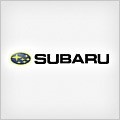
SUBARU Outback
Generations Timeline, Specs and Pictures
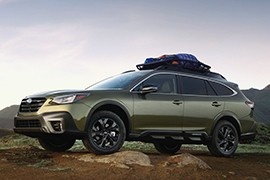
Subaru made a new generation of the Outback based on its latest global platform and it showed the model at the 2019 New York Auto Show.
Even though the look is almost the same as the generation it replaces it, it is actually an all-new car.
Under the hood, Subaru engineers installed the first turbocharged boxer engine on the Outback since 2009. The 2.4-liter flat-four packs a total of 260 HP and a maximum torque of 277 lb-ft (375 Nm). Base models and trims will have the naturally aspirated 2.5-liter engines, which will deliver only 182 HP. Regardless of their engines, all Subaru Outbacks will be paired with the new CVT gearbox, which has a manual function where the driver can choose between 8 forward gears.
From the safety point of view, the latest Subaru Outback offers a complete package of airbags and standard on all trims is Subaru’s EyeSight Driver Assist Technology, which includes Adaptive Cruise Control, Lane keep assist (which is called Lane Centering for Subaru) and other amenities. On top of these, there is also a head-up display offered as standard for all Outbacks.
As usual, Subaru kept its budget for the design department low so the new Outback doesn’t seem too new compared with the model it replaces.

The Subaru Outback was designed for active people who love to go hiking.
It was the up-lifted station-wagon version for the Legacy sedan. The 2015 model showed a big improvement in almost all areas.
The 2015 Outback didn’t want to look like a rugged off-road vehicle. It was a crossover and it wasn’t ashamed to tell that from the first look. It did have some off-road inspired details such as the black plastic details on the fenders or the bulky side-sills, but it was just a crossover built on a sedan chassis.
The exterior look was changed, with a raked windshield and roof-rails on top. A clever system allowed the driver to hide the transverse bars inside the long rails to decrease the wind noise when they were not used. A better aerodynamic helped the car to be quieter on the road and made the journeys more pleasant.
Inside, there was a new infotainment unit with a touch-screen for navigation and audio controls. There was room for five, but with limited leg-room for the rear-seat middle passenger due to the transmission tunnel.
As usual, the Outback featured the symmetrical AWD system. It was offered with two engine choices. The base model, with a flat-four 2.5-liter engine, was mated as standard with a 6-speed manual. The top of the range 3.6-liter was the same as before and mated exclusively with the CVT transmission. A manual mode with 6 preset gears was installed, with paddle shifters behind the steering wheel.
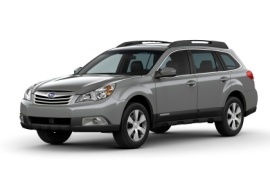
The 2009 Subaru Outback is the forth generation of Subaru, and it features a roomier cabin and an expanded luggage compartment.
This new-generation outback was launched at the 2009 New York International Auto Show, and it’s powered by two new improved engines that provide outstanding fuel economy available for the U.S. market. The interior is visible improved, both front seats excel in comfort and the incorporation of a new electronic parking brake eliminates the need for a side brake lever and creates more space for the center console. The exterior is also improved, the silhouette of the new Outback projecting a greater road presence.
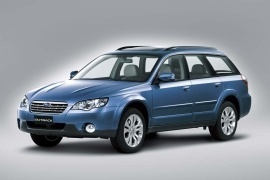
Designed for people with an active lifestyle, the Subaru Outback was a combination between an SUV and a wagon.
Based on the Subaru Legacy’s platform, the Outback had a rugged outdoor look with added ground clearance and protective side cladding.
The tall suspension configuration allowed a ground clearance of 8.7 inches, while the SUV styling cues featured pronounced wheel arches that made the Outback look handsome and confident.
Offered with a single wagon body style, the Outback ranged from basic to near luxury, depending on the trim level chosen.
A perfect match for those who were looking for an outstanding off-road performance, but not in the body of an SUV, the Outback felt like a mid-size sedan while driving and unleashed its nature on bumpier roads.
One of the best on the market, the Subaru’s symmetrical all-wheel-drive system was available, providing maximum traction.
The long list of accessories included roof rails, numerous cargo organisers and even a dog mat.
The cabin was fitted with good quality materials, the tall seating offered the driver a good view over traffic and the roomy seats in the back were perfect for 2 adults. The cargo space was a good size and allowed storing bigger items.
The instruments were easy to read, and the controls were intuitively placed.
The base version was not equipped with standard steering wheel-mounted audio controls. The base 2.5i came with a 5-speed manual transmission, front side and side curtain airbags and 4-wheel antilock disc brakes, as well as air conditioning, keyless entry and cruise control.
The Limited versions offered a turbocharges or a 6-cylinder engine, more powerful than the underpowered 2.4-liter, an automatic transmission, a power moonroof, dual-zone automatic climate control, 17-inch alloy wheel and a premium Harman Kardon audio system.
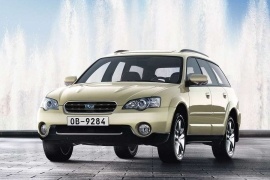
In 2003, Subaru introduced the fourth generation of the Legacy in both shapes, a sedan and a station wagon, and added a crossover version: the Outback.
While other carmakers had to work hard to develop vehicles for the new crossover market, Subaru had all the ingredients to build one and compete for the top-selling charts. Its only serious rival was the Audi A6 Allroad Quattro, which was much more expensive and played mostly in a different league.
The Outback was introduced for the first time on the second Legacy generation under the Legacy-Outback name. Over time, it evolved as a different nameplate in the Japanese carmaker lineup, even though it was based on the Legacy Wagon model. It featured a higher ground clearance and specific plastic moldings on the side, plus a pair of redesigned bumpers. The one in the front sported two large fog-lights. At the lower part, the plastic moldings were left unpainted.
Inside, the front bucket-seats provided good side support. Subaru’s designers installed a split-folding bench for up to three passengers in the rear, but with less room for the middle one since a transmission tunnel crossed the station wagon from front to back.
Subaru installed only two engine choices under the hood, with four and six-cylinders boxer engines paired to the Japanese brand’s well-known symmetrical all-wheel-drive system. Depending on the market and trim level, the carmaker installed manual or automatic transmissions.
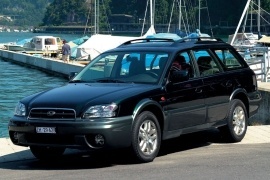
Subaru introduced the third generation of the Outback in 1999, and just three years later, it came with a facelifted version, which was kept until 2004.
The Legacy Outback was ahead of its times. It was a high-lifted version of the Legacy, and it appeared on the market in 1994. Five years later, Audi introduced their version of a lifted model for the A6 Avant, which was named Allroad. But Subaru was relentless and came at the same time with a completely new vehicle, the Subaru Outback. While it lost the “Legacy” part of the name, it became a stand-alone model, even though most of its parts were shared with other Subaru vehicles.
It was unusual for a carmaker to introduce a facelifted model in such a short time since the car’s launch. The second generation of the Outback was based on the third generation of the Legacy, and it was available in both shapes: sedan and estate, but the latter was the most successful version. The 2002 model-year featured improved stone protection thanks to wrapped around bumpers and plastic panels on the lower parts of the doors. In the rear, the cut-down bumper left more room for the tailgate.
Inside, the 2002 Outback featured new equipment such as the CD-cassette-radio. Depending on the trim level, two-tone leather upholstery was available, and some wood-trims on the dashboard and door panels. A Momo steering wheel was on the options list as well.
The biggest change was on the technical side, where Subaru installed its 3.0-liter Boxer engine. It was paired to the well-known symmetrical all-wheel-drive system or to an enhanced VDC that transferred the most torque to the wheel with the best traction.
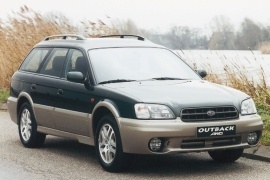
Subaru Outback is a crossover vehicle manufactured by Subaru since 1995 and is assembled at two plants located in Gunma, Japan and Indiana, USA.
The car is marketed as Legacy Grand Wagon in Japan since 1995 when it was officially introduced. The Americans call it Legacy Outback while in Australia Subaru promotes it as Outback. The design of the car was made by Olivier Boulay who also worked for Mitsubishi Grandis and for a couple of other concepts of the same company. The first generation of Outback could be found in two engine versions, a 2.2 liter developing 135 horsepower and a 2.5 liter producing 165 horsepower.























































